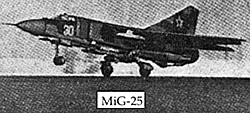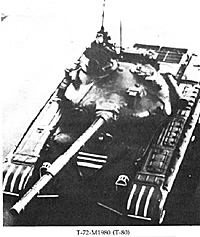 For the planners of Soviet military operations, the crux of the
issue is the technological advantages available to the Western forces.
For the planners of Soviet military operations, the crux of the
issue is the technological advantages available to the Western forces.
MiG-25
The Soviets accept the broad general advantages that the West has in both strategic and conventional forces. However, as noted previously, Soviet theorists believe that technology as applied to warfare exists in levels. The key, then, is to examine each level and to prepare an operational program to either directly combat that technological use by the West or to hinder its effectiveness in such a manner that the advantage is immaterial to the overall outcome of the conflict. Soviet planners are aided in this endeavor by the fact that the West places such extraordinary emphasis on technological achievement.
Soviet analysts recognize that technological achievement has great advantages, but they are also aware that within that achievement are major disadvantages. Technology is expensive and therefore the Western nations have been unable to purchase large quantities of equipment. In addition, sophisticated equipment is more difficult to maintain and long time delays exist between loss and replacement. Training of personnel is arduous and often incomplete. And, utilization often depends too greatly on other highly sophisticated operations occurring at the same time without a hitch. To effectively meet the West, Soviet military planners realize they must concentrate on defeating that element, technological advantage, which is critical to the West's doctrine.
The Soviets and their allies are well aware that in the area of super technology and high technology weapons systems, the West generally still holds an advantage. They believe, however, that if they can effectively combat the West on those two levels, the conflict will retrograde into a battle of moderate and low technology actions. At that point they feel they not only can but will win. Initial actions must then focus on those elements critical to the overall battle doctrine of the West, which are principally elements of super and high technology.
Western programs to combat the Soviet Bloc in any confrontation rely heavily on developing and maintaining a network of intelligence-gathering equipment, maintaining a massive communications and command structure, and allocating a finite number of highly capable weapons to the proper area. Western doctrine relies almost exclusively on the ability of NATO forces to supply real time transfer of information to combat command units for the effective employment of men and equipment. Without such reconnaissance available, the interdiction program against follow-on Soviet echelons and reserves cannot work. Additionally, Western forces must have the military resources available for use in applying their doctrine or no advantage can be taken based on intelligence data collected.
Surprise
To facilitate combatting the technological advantage of the West, the Soviet Bloc will rely on a critical facet of long standing Soviet military philosophy. The attack on the West will involve as much as possible the element of surprise. Surprise accomplishes a number of things. First, a surprise attack will cut down the preparation time available to the West and at the same time narrow the response time for interdiction of the logistical elements of the Soviet forces. Second, a surprise attack will create confusion among the allied command structure and the governments of the allied nations. Third, and most importantly in am examination of Soviet methodology for dealing with the West's technological advantage, a surprise attack will enable Soviet forces to eliminate and/or curtail the application of elements of technology essential to the Western response.
Within as narrow a time frame as possible, the Soviet Bloc will attack any and all intelligence-gathering equipment, supply depots, communications and command centers, and airfields available to them. These attacks will be carried out by both conventional forces and teams of saboteurs.
Although many would argue that the United States and its allies have the most sophisticated and developed network of intelligence gathering equipment, much of it is highly vulnerable to attack. Initial Soviet attacks will be made on these resources. In recent years, evidence has come to light that the Soviets have developed very capable killer satellites, which can not only attack Western intelligence-gathering and communications satellites, but can move from orbit to orbit to attack another object in space. Destruction of these major facets in the West's network will do serious damage to any response to a Soviet invasion.
Acting in concert with the satellite systems are airborne systems carried by various AWACS and other surveillance aircraft. Not as vulnerable as satellites, such aircraft are few in number and will require extensive protection from other aircraft with both high grade electronic countermeasures capability and sufficient armament to combat Soviet interceptor attack. Besides outright attempts to shoot down these aircraft, the Soviet Bloc nations will utilize a large force of aircraft carrying equipment designed to interrupt the ability of the AWACS aircraft to communicate with either ground forces or other aircraft. Any success that the Soviet Union has in attacking these aircraft will contribute greatly to the confusion among allied forces and severely hinder counter-operations.
Besides attacking the very gatherers of information, the Soviets will also attempt to destroy or damage the receiving centers of the data transferred. Utilizing special teams of commandos, infiltrated into the Western nations before the invasion begins, the Soviet military will seek to break down the communications network of the NATO partners. The attacks will focus on the military centers, but will include those civilian operations designated as appropriate. Disruption of these centers will cause delays in attempts to coordinate between allied military forces and governments, and will help generate confusion among the civilian population. When commando teams are deemed unsuitable for attacking a particular facility, conventional assault teams or air attacks will be designated in an attempt to reach and neutralize the target.
At the same time that efforts are being made to destroy or disrupt the intelligence-gathering and communications network, other attacks will be launched. A key element in the West's reinforcement program is the existence of equipment depots prepared for use by troops needing resupply and troops arriving from allied nations, particularly the United States. By destroying these depots or isolating them from the incoming troops, the Soviets will have negated those allied troops from being any practical value to the West. These attacks will be carried out by teams of saboteurs and, more importantly, airborne troops. In recent years, the Soviets have developed a powerful component of regular commandos with high mobility, both to the target area and on the ground once the target is reached. Although not capable of withstanding a full armored assault, these troops are more than capable of attacking and disrupting rear areas of the NATO command.
 T-72-M1980 (T-80)
T-72-M1980 (T-80)
The rear area attacks by Soviet forces will concentrate on one other area of critical importance, both to the projected success of the Soviet invasion and to the response capability of the West. Employing a variety of methods, including saboteurs, assault teams, and air attacks, the Soviet Bloc will attempt to damage the major military airfields available to the Western allies. The employment of aircraft is vital to NATO in nearly every aspect of its confrontation with the Soviets. Aircraft are needed for intelligence gathering or delivering men and materials, and, if short and medium-range missiles are unavailable, for implementing the interclictory aspect of the West's battle doctrine. The task of disrupting the use of these facilities to allied aircraft is not as formidable as might first appear. Realize that the allies have only sixteen major military airbases in West Germany, for example. Relatively few in number, these bases hold a disproportionate amount of the military air forces' aircraft, men, and logistics support available to NATO nations.
The opening moves in the rear areas will require a great deal of coordination and equipment. In terms of saboteur teams, the ability of the Soviet Bloc countries to provide such, either from their population or by utilizing terrorist and guerilla squads from outside allies, is open to little question. Currently, nine air assault divisions are on active status facing the nations of NATO. Since 1974, the Soviet Union and its allies have increased their intelligence-gathering operations significantly. Large number of aircraft have been converted from their previous status to acting as airborne surveillance aircraft and electronic counter measures platforms. Although rarely as sophisticated as Western SR-71s, TR-1s, RC-135s, and British Nimrod conversions, the vast number of "Coots", "Badgers", "Bears", and "Cubs" available to the Soviets pose a serious threat to the effectiveness of Western intelligence-gathering and communications activities.
The key point in any discussion of these opening moves by the Soviet Union is that the Soviets do not necessarily seek to completely destroy - nor do they need to - even a single element targeted by these attacks. The important factor for the Soviet forces is the degree to which the effectiveness of Western operations and facilities can be damaged. Soviet Bloc military leaders know that the Western Allies depend greatly on these elements for the effective use of the forces available to combat a Soviet invasion.
More Soviet Conventional Combat Philosophy by Owen Stanley
- Introduction
Soviet Military Thought
Laws of Military Conflict
Soviet Planning
Opening Assault
Conclusion
Back to Table of Contents: CounterAttack #1
To CounterAttack List of Issues
To MagWeb Master Magazine List
© Copyright 1987 by Pacific Rim Publishing Company.
This article appears in MagWeb (Magazine Web) on the Internet World Wide Web.
Other military history articles and gaming articles are available at http://www.magweb.com